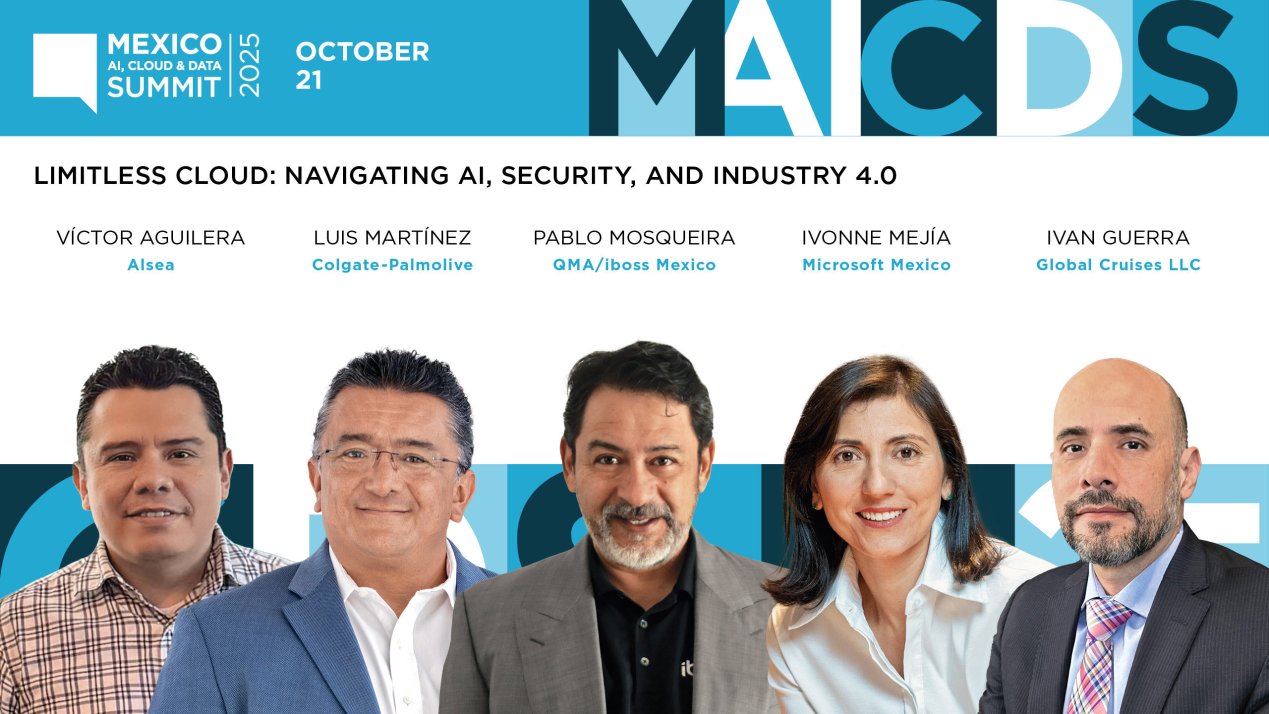The fourth industrial revolution has become a contemporary imperative. However, as large enterprises benefit from the convergence of cloud computing, AI and the Internet of Things (IoT), a growing implementation gap threatens to leave behind most of the industrial sector, which faces systemic barriers to cost, talent and cybersecurity.
“There are intriguing prospects for cloud adoption in Mexico. This is not a new discussion; it has been developing for years,” said Ivonne Mejía, Strategic Accounts Sales Director, Microsoft Mexico. She adds that hybrid and public cloud models are already at about 70% combined adoption in the country, meaning billions of dollars for the economy. “Value creation and time to market are critical because this is where we connect the value that the cloud brings to businesses,” she adds.
The core of the challenge lies in the friction between technological vision and operational reality. This gap manifests itself in concrete technical challenges that slow adoption, such as: Examples include a lack of interoperability between proprietary platforms, compatibility issues with older devices that cannot connect to new digital infrastructure, and the persistence of data silos that fragment information and hinder decision-making.
“We live in a time where the fourth industrial revolution is defined by connectivity,” says Iván Guerra, IT Director, Global Cruises LLC. “Digital technologies, devices and systems are merging to create a hyper-connected ecosystem that operates in real time and generates massive amounts of data for instant decision making. However, this expands the spectrum of vulnerabilities and the cloud plays a strategic role in addressing these vulnerabilities.”
The cloud acts as a flexible and secure platform that enables companies to innovate, but also requires new forms of financial and operational alignment. “From a technical perspective, moving to the cloud is easy, but we also need to consider the financial and operational implications,” says Guerra.
These barriers to integration are not trivial; They represent a systemic barrier that prevents many organizations, particularly SMEs, from fully realizing the promised benefits of increased flexibility and efficiency. Despite the progress, “only 12% of SMEs in Mexico have started digital transformation, and the same percentage are actively considering cybersecurity in their strategy,” says Mejía.
The push for industrial digitalization is being driven by exponential market growth. The global Industry 4.0 market, worth $146.14 billion in 2022, is expected to reach $627.59 billion by 2030. This progress is accelerated by underlying technologies such as AI, whose market is expected to grow from $279.22 billion in 2024 to nearly $3.5 trillion in 2033.
At the heart of this transformation is the cloud, which acts as the foundational infrastructure that enables scalability and large-scale data processing. However, this rapid technological expansion is not evenly distributed. While large companies have the resources to invest and experiment, SMBs face several obstacles that slow adoption.
“The cloud helps centralize data, which is fundamental to developing breakthrough solutions,” said Luis Arturo Martínez, senior director of information technology, Colgate-Palmolive. He adds that centralized data enables innovations such as digital twins to optimize processes, but also introduces new risks. “A connected industry includes hundreds of thousands of devices connected to the cloud – many of which lack adequate security standards. Increasing connectivity means a higher number of potential entry points for cyberattacks,” he warns. Martínez emphasizes the importance of building a culture of shared responsibility: “We need to evangelize technology teams along with business leaders. If the people running the systems don't understand the financial and operational implications, every cloud action incurs costs.”
The transition to Industry 4.0 is not a simple technology upgrade, but a complex business transformation that presents interconnected challenges. Financial constraints, skills shortages and cybersecurity threats create a triple hurdle that companies must overcome.
“Cybersecurity is both the be-all and end-all and the cost factor,” says Víctor Aguilera, CIO of Alsea. Even the most advanced systems rely on a strong safety culture, he adds. “Many organizations still view cybersecurity as the responsibility of IT, when in reality it is part of every process and business area.”
As organizations face increasingly complex cyber threats, the need for integrated, proactive security models becomes more urgent. “The cloud is the engine of the new industrial revolution,” says Pablo Mosqueira, Director and Strategic Partner, QMA/iboss Mexico. “Cybersecurity must be designed starting from the architecture and not added as an afterthought. In Industry 4.0, the concept of a defined perimeter no longer exists – everything is connected through IT and cloud models, which fundamentally changes risk structures.”
Meeting the challenges of Industry 4.0 requires not only technological innovation, but also new business models, collaboration strategies and an open dialogue between technologists, industry leaders and regulators.
“We see the integration of generative AI with the cloud to accelerate optimization and detect anomalies. The cloud, along with innovations such as encryption and predictive risk models, will make Industry 4.0 safer and more efficient,” says Mosqueira.
Adaptability and culture remain central. “AI will change the way we work and act. Our work will change and evolve; of course we can decide how we adapt. We must learn to change and grow with AI,” says Aguilera.
Practical implementation is just as important. “Today it is much clearer; general managers are talking about AI and the purpose is beginning to be understood. What is still missing is the 'how'.” At Microsoft we differentiate between three phases: firstly, the use of generative AI for advice without generating concrete measures; next, humans collaborate with agents, combining human and AI capabilities; and ultimately becoming a “manager of agents,” where the work changes rather than disappears,” says Mejía.
The successful introduction of Industry 4.0 combines intelligent cloud-based systems, resilient cybersecurity and empowered people. Companies that align technology, talent and strategy will realize the full potential of AI, IoT and cloud innovations while navigating the complexities of the modern industrial landscape. “The key to success lies in democratizing and strengthening the organization, because technology leaders alone cannot achieve this,” says Mejía.
